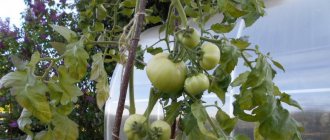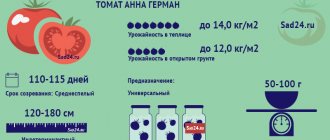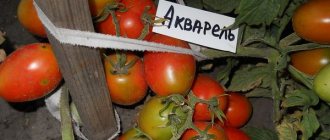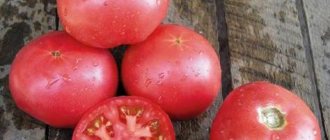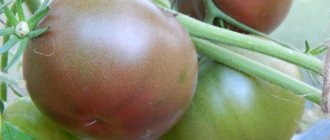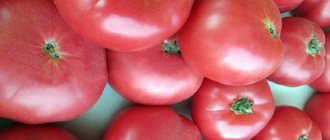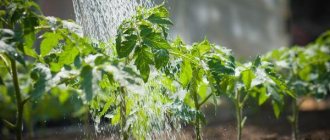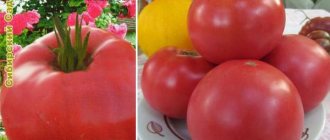Description of the tomato variety Windrose
The Wind Rose variety was bred by Russian breeders. In 2003, the variety was included in the State Register of the Russian Federation. According to the characteristics and description, Windrose tomatoes are suitable for cultivation in the northern regions of Russia in open ground and greenhouses.
Windrose tomato bushes do not exceed 40 - 45 cm. Experts recommend growing them in several stems to obtain maximum yield.
A heavily leafy plant with narrow, slightly pubescent leaves, the edges of which are corrugated. The color of the foliage of tomatoes of this variety is light green. Pale pink flowers distinguish Compass Rose from other tomato varieties. The fruits are smooth with a dense, glossy skin. Ripe tomatoes may be pink or dark pink in color.
From the moment of germination to the onset of technical ripeness, Windrose tomatoes need only 95 days.
Characteristics
The main characteristics of the variety are:
- The fruits are large, smooth, round. Weight 120-130 grams.
- The skin is moderately dense, glossy.
- During the ripening process, the color changes from green to warm pink.
- The pulp is juicy, not watery, with a pleasant sweetish taste.
- There are few seed chambers, the high content of sugars, amino acids and beta-carotene makes it possible to recommend the fruits for baby and dietary nutrition.
You can compare this indicator with other varieties in the table:
| Variety name | Fruit weight |
| Rose of Wind | 120-130 grams |
| Verlioka | 80-100 grams |
| Fatima | 300-400 grams |
| Yamal | 110-115 grams |
| Red Arrow | 70-130 grams |
| Crystal | 30-140 grams |
| Raspberry ringing | 150 grams |
| Cranberries in sugar | 15 grams |
| Valentina | 80-90 grams |
| Samara | 85-100 grams |
A salad variety, the fruits are used for preparing appetizers, soups, hot dishes, sauces and purees. Ripe fruits produce a delicious thick juice of original pink color. Canning is possible.
Pros and cons of the Windrose tomato variety
A high-yielding hybrid variety of tomatoes does not require special attention when growing. Wind rose is cold-hardy and resistant to common tomato diseases. Compact plants allow you to get high yields of tomatoes in small areas.
The fruits are well stored and do not deteriorate during transportation. You can pick unripe tomatoes and ripen them at room temperature. According to reviews, the Wind Rose variety, under favorable weather conditions, produces up to 3 kg of tasty tomatoes from one bush.
Pests and diseases
Farmers who have known this variety for a long time note its resistance to fungal and viral diseases.
However, to definitely avoid this, it is recommended to take the following preventive measures:
- Spider mites are removed with insecticides. However, they can be used before buds begin to form.
- Slugs do not appear with regular mulching with peat or straw, as well as loosening the soil.
- Other insects are removed with a soap solution and a mixture of water with the addition of ammonia.
- Every year the top layer of soil is replaced with mandatory disinfection of the new soil with a solution of potassium permanganate.
- Remove the lower leaves.
Growing
Windrose tomatoes can withstand unstable weather quite easily. Therefore, they can be grown in greenhouses and under temporary shelter in the open ground. Mature plants can withstand even the first autumn frosts without damaging the fruit.
Growing seedlings
Tomato seeds are sown for seedlings from mid-March until the first ten days of April. The soil is prepared in advance from equal parts of peat and garden soil. To protect seedlings from pests and diseases, the soil must be treated with special anti-fungal solutions or calcined in a hot oven.
To stimulate germination, you can soak the seeds in a solution of Epin, Heteroauxin or a similar preparation. Sow the seeds in abundantly moistened soil at a distance of 1 - 1.5 cm. Cover the container with the crops with film and put the mini-greenhouse in a warm place. The optimal temperature for germinating tomato seeds is +23 - 25 oC.
Important! The mini-greenhouse must be ventilated regularly to prevent the formation of mold.
With the appearance of the first loops of seedlings, the box is placed in a sunny place and the film is removed.
During the entire period of growing seedlings, it is necessary to prevent the soil in the box from drying out. Watering should not be frequent, but even and plentiful.
When the plants produce 2-3 true leaves, the seedlings are planted in separate pots or boxes at a distance of at least 7-8 cm.
To enhance the development of the root system, the main root of the seedling must be shortened by at least a quarter of the total length. This stimulates the development of lateral roots and ensures the result in the form of strong and strong tomato seedlings.
Landing rules
Before planting seedlings in open ground or a greenhouse, it is necessary to harden them. In May, when the air temperature rises above 15 ° C, tomato seedlings can be taken out onto the open veranda for several hours. At lower temperatures, hardening is carried out with open windows, gradually increasing the ventilation time.
Tomatoes should be planted in the ground in late May or early July, depending on temperature trends in the region. It is important that the threat of return frosts, which are dangerous for young plants, has passed.
The area for tomatoes is dug up to a depth of about 30–40 cm. Organic fertilizers (humus, compost) or mineral complexes with a predominant nitrogen content are applied.
Compact, low-growing bushes do not take up much space, so they can be planted with an interval of 36 cm between plants and 60 cm between rows.
Advice! Tomatoes love to be planted “in the mud.” To do this, pour up to 2 liters of warm water into the holes and dig in the seedlings.
Watering and fertilizing
Windrose tomatoes are not demanding on moisture. They tolerate short-term drought quite easily. But to get a good harvest, they need watering every week. Up to 2 - 3 liters of water are consumed per bush. When hot weather sets in, you can increase the frequency of watering.
To retain moisture in the soil and reduce the likelihood of weed growth, the space around the tomato stem is mulched with well-rotted humus with the addition of sawdust.
Feeding is carried out once every two weeks. If during planting the soil was well fertilized with nitrogen components, then there is no need to add more. Due to the abundance of nitrogenous compounds, tomatoes fatten (increase green mass to the detriment of fruiting).
Experts recommend using solutions containing potassium, phosphorus and boron as root fertilizers. You can use any medications following the instructions for them.
Potassium is required by tomato plants during the flowering period. If you are late with fertilizing, some of the flowers will fall off.
Attention! The need to add potassium is visible from the condition of the plant leaves. When the element is deficient, the foliage loses color.
Experienced gardeners use a 1% solution of boric acid as foliar feeding. In the evening, tomato plants are sprayed, intensively wetting the leaf plates. The first fertilizing with boron can be carried out at the beginning of flowering, and the second - during the period of mass ripening of fruits. This method not only saturates the plants with boron, but also promotes the development of immunity against rot and fungus.
Pinching and tying
The low-growing determinate hybrid Wind Rose does not require pinching or gartering when planting. The thick elastic stem perfectly withstands the deciduous mass. But with abundant fruit development, it is advisable to tie up the bushes. According to reviews and photos, the Wind Rose tomato shows high productivity. Bushes without supports and garters are not able to support such a number of tomatoes.
Formation
When growing in a greenhouse, tomato bushes do not need to be formed. If the plants become too elongated, their main stem should be shortened.
In open ground, if side shoots develop excessively, you can remove the latest ones, leaving 3 - 4 stems. This formation is carried out when growing Windrose tomatoes in regions with a cool climate. In the southern regions, bushes do not require formation even when cultivated in open ground.
Protection from diseases and pests
The Wind Rose variety was specially bred for risky farming areas. The main feature of the hybrid is its resistance to disease. According to reviews, when grown in greenhouses with high humidity, you can protect tomatoes from fungus by regulating moisture by ventilation.
Advice! When grown in areas infested with pests (whitefly, aphids, spider mites), tomato bushes are treated with standard insecticides for prevention.
Against late blight, which can destroy already ripening tomatoes, you can use harmless agents in the form of boric acid, copper sulfate or biological preparations.
Rules for planting and care
Seeds for seedlings of the Wind Rose variety begin to be sown in late March - early April. This period is suitable for planning planting in the ground during the first week of June. Recommendations for care and planting:
- carrying out soil disinfection;
- step-by-step seed preparation;
- additional fertilizer with mineral mixtures;
- choosing a site with neighbors suitable for the culture.
Growing seedlings
Seeds of the Windrose variety must be placed in a root biostimulator. This rule applies to all early ripening varieties of tomatoes. After soaking for 12 hours, dry them at room temperature. If necessary, the seeds are processed additionally:
- hardening (recommended for northern regions);
- germination (when planting a small number of seedlings in order to exclude the admission of non-viable material to sowing);
- calibration (for screening out empty seeds).
The soil for sowing is hardened or calcined. It depends on the individual preferences of the summer resident. To warm up, the soil is placed in an oven and kept at a temperature of +70 °C.
For hardening, it is frozen at -10 °C 2 - 3 days before sowing.
The Wind Rose variety is usually sown in common containers, and after germination and the appearance of the 3rd - 4th leaf, picking is carried out. Weak sprouts are left on the windowsill at a temperature of +22 - 24 °C and a stable supply of sunlight. Strong seedlings begin to be prepared for planting in a permanent place of growth.
Transplanting seedlings
Seedlings are transplanted as the soil is prepared:
- for greenhouse cultivation, plantings are planned for early to mid-May, provided the soil warms up to +18 °C;
- for mini-greenhouses, choose a period when the possibility of return frosts is excluded;
- for open ground, the timing may shift depending on climatic conditions, however, the open soil must be warmed up to at least +15 °C.
The soil is dug up 1 week before planting. Organic plants are added. When planting, mineral fertilizers are applied. Those who planted the Wind Rose on their plot recommend adding a bucket of hot water to the hole before planting. This method helps the sprouts adapt faster and withstand temperature changes without energy costs.
Mini-greenhouses are additionally covered with plastic film, since greenhouse plantings are carried out earlier than plantings in open soil, which means that the age of the seedlings requires additional care.
Information! High beds are organized for mini-greenhouses: many summer residents, in addition to industrial structures, use barrels, tanks, and containers.
For planting, the size of the bushes is taken into account. According to the manufacturer's recommendations, each sprout is planted at a distance of 35 - 40 cm from the other. The distance between the rows is up to 60 cm. This scheme will allow garters, pinching and harvesting to be carried out unhindered.
Tomato care
Windrose tomatoes require regular weekly watering. They are able to tolerate periods of short-term drought and calmly respond to slight waterlogging, but violation of watering rules immediately affects the yield.
Advice! In the 2nd week after planting, additional preventive treatment against late blight is carried out. The bushes are sprayed with a solution of tobacco or special-purpose chemicals.
For feeding, mineral complexes with potassium and phosphorus are used. Liquid mixtures are applied at the root every 2 weeks. This is not a prerequisite, but can help increase yields.
To get rid of weeds and prevent the appearance of insects, tomatoes of this variety are mulched immediately after planting. Sawdust and pine needles are suitable for mulching.
The bushes do not need pinching: due to their short stature, bush formation is not practiced. In order for the bush to withstand the weight of the formed tomatoes, several garters are made.
Advice! It is recommended to plant calendula or marigolds next to tomatoes. This proximity protects tomatoes from insect invasion.
Disease and pest control
Seedlings require preventive treatment
To prevent late blight, seedlings are sprayed with Bordeaux mixture immediately after transplanting to the garden bed. If there is a predisposition to the disease (other tomatoes are infected with late blight or were sick last year), treatments are done every 12 days.
The soil in the garden bed is sprinkled with ash, and the tomatoes are watered with an ash solution. If obvious signs of late blight appear, treat the plants with copper oxychloride.
According to the characteristics, the Windrose tomato is often plagued by whiteflies. You can fight it with the help of special sticky traps. In addition, it is recommended to wash the leaves with a solution of laundry soap. It is also useful to spray plants with infusion of tobacco or garlic.
In serious cases, special drugs are used (“Fitoverm”, “Aktara”). If a spider mite is noticed, you need to wipe the leaves with medical alcohol or use appropriate preparations for control (Barrier, Agravertin, Barrier).
Advantages and disadvantages
Plants need to be fertilized regularly
The advantages of the variety include:
- beautiful fruits with good taste and universal purpose;
- high yield (3 kg per bush);
- early ripening;
- resistance to cold, drought, weather changes;
- excellent keeping quality and transportability of fruits;
- compact bushes.
The variety has few disadvantages:
- To get a good harvest, regular fertilizing is necessary;
- tomato can suffer from late blight;
- Lush foliage needs to be thinned frequently.
Reviews from gardeners
Igor Kartavtsev, Chelyabinsk
We have been growing the Windrose tomato for the third season. We want the harvest early, so we don’t wait: we grow seedlings on the windowsill, and then plant them in a greenhouse under film. The bushes grow quickly and begin to bloom. We remove almost a bucket of tomatoes from one bush. I don’t know of any variety that is so productive. They are also very tasty, just like fatty, meaty, juicy and sweet. We love them in salads and lecho.
Svetlana Primorskaya, Tomsk
The Wind Rose tomato has become our family's tomato: I have already given it to my mother, my sisters, and even my neighbors. The tomatoes are delicious, they ripen together, and in a short summer we have time to finish the pickles, prepare the juice, and eat to our heart’s content. It’s not difficult to care for at all, they don’t take up much space, and they’re so productive that it’s hard to believe. Then you get used to it)
Alina Kochura, Krasnodar
We plant the Windrose tomato directly in the ground with seeds, it pops up quickly, no problems at all. We water and feed 1-2 times. We remove 6-7 kg from the bush, one of the most favorite varieties.
Children always choose them to eat: pink, sweet, meaty, simply delicious.
Diseases and pests of rose stock
Despite the growth of the plant and its unpretentiousness, mallow is susceptible to diseases: powdery mildew, rust, and nematode damage. Such phenomena occur due to excess humidity, damp and cold weather, as well as poor lighting.
Of course, it is impossible to prevent the occurrence of the disease, but it is possible to treat the flower beds. When the first signs of disease appear, the plant is fed with a solution of fungicides. During the period of rust infection from the mallow, it is necessary to tear off the affected leaves and treat with Bordeaux mixture.
If harmful inhabitants appear on the flowers, then the plant should be sprayed with an insecticide solution.
Brief information about the variety
- Fruits and bush : tomatoes are deep pink in color, flat-round in shape, weighing from 100 to 150 g; determinate bush, standard, 40-50 cm high.
- Productivity : high for a standard variety (2-3 kg per bush).
- Resistance : Resistant to most diseases, but can be affected by late blight.
- Distribution : Recommended for northern regions, but can be grown throughout the country.
- Application : salads, pickling, canning, processing.
- Planting : seedling method; sowing seeds for seedlings - in mid-March or early April, transplanting into a greenhouse - in mid-May, into open ground - in late May or early June; planting pattern – 35-40 cm by 50 cm.
- Soil : light, with organic fertilizer.
- Care : watering - once a week, fertilizing - once every 2-3 weeks, thinning leaves, tying fruit clusters.
- Ripening period : early ripening - the harvest is harvested 95-100 days after seed germination. Long-term storage of fruits is possible.

